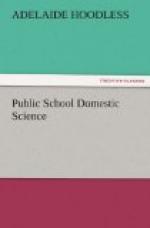COOKIES (PLAIN).
1/2 cup butter. 1/4 cup milk. 2 even tsps. baking powder. 1 cup sugar. 1 egg. Flour to roll out thin.
Cream the butter, add the sugar, milk, egg beaten lightly, and the baking powder mixed with two cups of flour, then enough more flour to roll out. Roll a little at a time. Cut out. Bake about 10 minutes.
LAYER CAKE.
1/2 cup butter. 1 cup sugar. 2-1/2 cups flour. 3 eggs. 2/3 cup milk. 4 (l.) tsps. baking powder.
Beat the butter and sugar to a cream, then add the yolks of the eggs gradually; then the flour and milk alternately (sifting the baking powder with the flour), add the well-beaten whites last. Bake in 3 tins in a moderate oven about 15 minutes. (Flavoring has been omitted in this recipe as the cake is more delicate by allowing the filling to provide the flavor.)
PLAIN FRUIT CAKE.
3 eggs. 1 cup milk. 1 oz. candied lemon. 4 (l.) tsps. baking powder. 2/3 cup butter. 3 (l.) cups flour. 1 cup raisins.
Mix as directed in preceding recipe, only mixing the fruit with the flour and baking powder.
ICING.
Whites of 2 eggs.
1/2 lb. powdered sugar.
1 tsp. of lemon juice.
Have the material very cold. Break the eggs carefully, beat the whites until frothy (not stiff); sift the sugar in gradually, beating all the while; add the lemon juice and continue beating until fine and white, and stiff enough to stand alone. Keep in a cool place, when using, spread with a knife dipped in cold water. If used for ornamenting press through a tube. It may be divided and different colorings added.
BOILED ICING.
1 cup granulated sugar. 1/3 cup boiling water. 1/4 tsp. cream of tartar. White of 1 egg.
Boil the sugar and water together until it hangs from the spoon. Beat the egg to a stiff froth, add the cream of tartar, then pour on the syrup, beating all the while. Beat until cold and thick.
* * * * *
PASTRY.
Pastry, unless light and tender, should never be eaten; even then it should be avoided by people with poor digestion. There are so many food preparations superior to pastry in both nutritive value and cost of time and material, that it will be wise to give it a very secondary place in the training of a culinary artist. However, as it is still a popular fancy with many, we may as well make the best of it. Butter is more wholesome in pastry than lard, although the latter makes a light crust. In order to secure satisfactory results in pastry making—especially puff pastry—three things should be observed: (1) have all the materials cold; (2) use as little liquid as possible; (3) handle lightly and quickly. Pastry should be very cold when it is put into the oven. Have the oven very hot.




